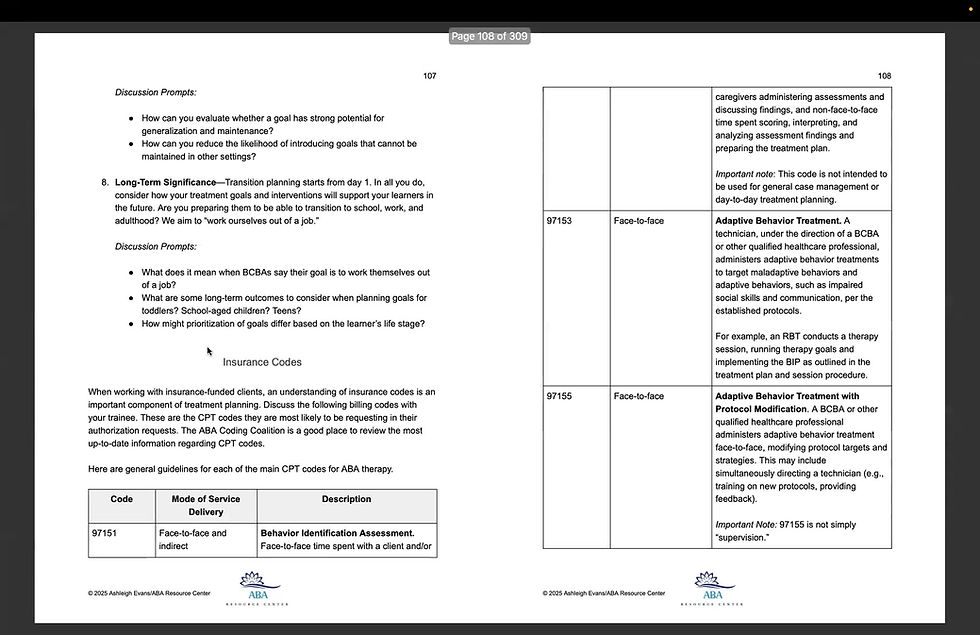The Growing Demand for ABA: Career Opportunities in a Rapidly Expanding Field
- Ashleigh

- Jul 21
- 5 min read
Updated: Aug 4
The field of Applied Behavior Analysis (ABA) has experienced exponential growth over the last decade, and this trend is projected to continue in the foreseeable future. The opportunities for RBTs, BCBAs, and mid-level supervisors are quickly expanding. Let's take a closer look at the growing demand for ABA services and what this means for current and future clinicians.
Factors Contributing to Growing Demand for ABA
Several factors contribute to the growth within the ABA field. First and foremost, it's important to recognize that ABA is a relatively new field. The Behavior Analyst Certification Board (BACB) was only established in 1998. Since then, the field has rapidly evolved.
Some of the main factors driving the growing demand for ABA include:
Rising Prevalence of Autism Spectrum Disorder (ASD): ABA can be used with everyone. However, a majority of the field works with autistic children. As the prevalence of ASD increases, so does the demand for services to support these learners in developing socially significant skills and behaviors.
Increased Awareness and Advocacy: Improved public understanding of autism and ABA therapy leads to professionals referring families to ABA therapy, resulting in more families accessing care.
Legislative Changes and Funding: Insurance mandates caused major shifts in the accessibility of services. In the past, ABA was often reserved for families who could afford to pay out of pocket, drastically limiting its reach. Now, ABA coverage is mandated across all 50 states.
Growing Recognition of Early Intervention Benefits: Research has established the critical importance of early intervention. As children receive diagnoses, parents are quicker to act, seeking out support through ABA, speech therapy, and other avenues. Earlier diagnoses, resulting from routine screenings, have also contributed to learners being able to begin care at an earlier age.
Broadening Applications of ABA: Another factor contributing to the growth of ABA is the expansion of its applications beyond traditional autism care. While ABA is most often associated with "autism therapy," its use is increasing across other areas, including in schools, hospitals, and even within corporate settings. Curious about career options within ABA? Check out this article, BCBA Career Paths: Exploring Diverse Career Options for BCBAs.
The ABA Clinician Shortage
Despite the field's rapid growth, we've struggled to keep pace with rising demand. According to the US Employment Demand for Behavior Analysts report, there were 103,150 open BCBA job postings in 2024. At the end of that year, there were only 74,125 total BCBAs. This significant gap underscores a nationwide workforce shortage that's affecting providers, families, and organizations.
Many organizations are operating at or beyond capacity, with long waitlists for services. For aspiring ABA professionals, this presents a unique opportunity. There has never been a greater need for behavior technicians and behavior analysts. For current professionals, the clinician shortage means ample opportunities for career advancement.
Career Opportunities in ABA
With demand at an all-time high, career opportunities in the field have never been stronger. ABA offers a variety of rewarding career paths, including:
Behavior Technician/Registered Behavior Technician (RBT): Behavior Technicians are the backbone of ABA programs. This entry-level position is often the first step into the field of ABA. Behavior technicians provide direct, one-on-one therapy to learners, helping them build communication, social, and daily living skills, while reducing behaviors that interfere with learning and independence. Click here to learn how to become certified as a Registered Behavior Technician (RBT).
Lead RBT: Many companies offer an RBT leveling system, providing opportunities to grow within the behavior technician role, such as becoming a Lead RBT. These roles typically come with increased pay and additional responsibilities, such as training new technicians.
Mid-level Supervisor: The mid-level supervisor serves as a bridge between the behavior technicians and the BCBA. The mid-level supports the BCBA in supervisory responsibilities and case management. Often, this role is dedicated to Board Certified assistant Behavior Analysts (BCaBAs). However, many companies also hire non-certified mid-level supervisors, such as those accruing their BCBA fieldwork hours. This is a perfect role for individuals to gain hands-on experience while working toward certification.
Board Certified Behavior Analyst (BCBA): BCBAs design and oversee ABA programs. They conduct assessments, create programming, train and supervise technicians, monitor progress, provide caregiver training, and more. Click here to learn how to become certified as a Board Certified Behavior Analyst (BCBA).
Leadership Positions: Experienced BCBAs often move into leadership roles, such as:
Lead BCBA
Clinical Director
Clinical Manager
Quality Assurance Specialist
Training Coordinator
Director of Clinical Services
Chief Clinical Officer
Administrative Positions: In addition to clinical roles, there are also administrative positions within ABA that are vital for maintaining smooth operations, such as schedulers, billing specialists, intake coordinators, and office managers.
Why Pursue a Career in ABA?
Embarking on a career in ABA means stepping into a field where your work has the power to make a real and lasting impact. ABA professionals play a critical role in helping people build meaningful skills, increase independence, and improve their overall quality of life.
The reasons for pursuing a career in ABA are endless. Here are just a few.
High demand and strong job stability.
Vast opportunities for career growth and advancement.
The ability to make a meaningful difference in the lives of your clients.
Diverse work settings—homes, clinics, schools, and telehealth.
Rewarding and fun work.
Gain transferable skills that apply across many fields.
Your Future in ABA
Ready to make an impact? Demand for ABA professionals continues to grow. Whether you're interested in becoming an RBT or looking ahead toward BCBA certification, the opportunities are endless.
Frequently Asked Questions
Does the ABA field have high job security?
Yes, the demand for ABA is high and continues to grow, making for strong job security.
How long does it take to become an RBT?
It can take anywhere from a couple of weeks to a few months to complete the requirements to become a Registered Behavior Technician.
How long does it take to become a BCBA?
In total, it takes at least 6 years to become a BCBA. This includes time to earn an undergraduate degree, a master's degree, complete fieldwork hours, and pass the BCBA exam.
Is a degree required to work in ABA?
You can work as a Behavior Technician or RBT with a High School Diploma or equivalent. However, higher positions in the field do require degrees.
What populations do ABA professionals work with?
The majority of ABA professionals work with autistic children, adolescents, and adults. However, ABA is not limited to autism. Some professionals in this field also work with individuals with other developmental and intellectual disabilities. Others also work with the elderly population, in general education settings, higher education, mental health settings, substance use treatment, and organizational behavior management (OBM).


































Comments